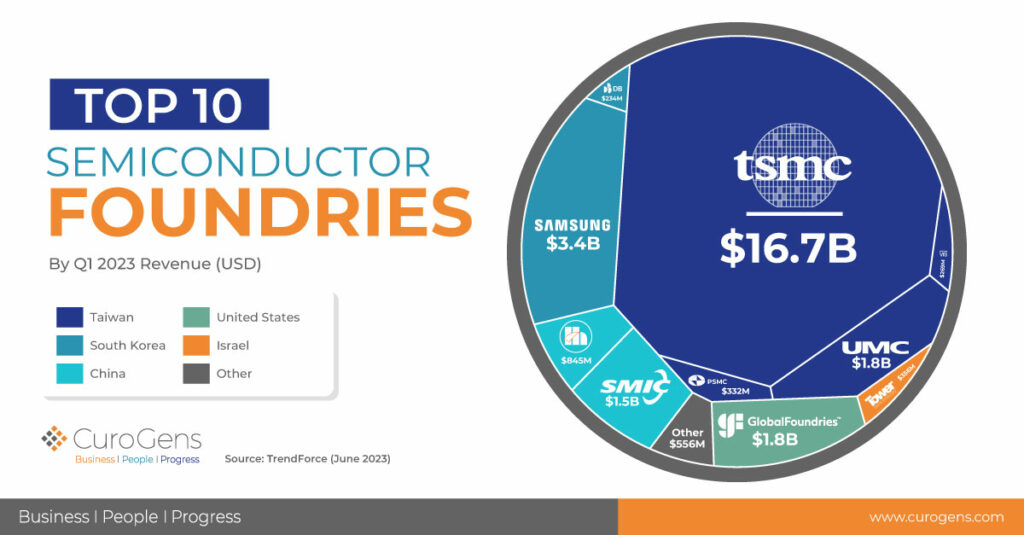Home The rise of the Semiconductor giants: A Q1 2023 analysis
Semiconductors are the beating heart of modern technology. Their role is critical in an era where digitization has touched every aspect of our lives. The pandemic brought along an acceleration of digitization, resulting in a demand for chips escalating to unprecedented heights and reflecting society’s growing dependence on technology.

The first few months of 2023 have revealed a robust and growing semiconductor industry vital to the digital economy. Revenues from leading semiconductor foundries, as seen in the chart, are a testament to the health of the sector.
Growing semiconductor industry in the digital economy.
TSMC stands out with revenues of $16.7B, dominating the industry and demonstrating the importance of innovation and scale. Samsung, with $3.4B, underscores the diversity of the competition, while SMIC and UMC consolidate the Asian presence in the global market.
These foundries are essential to the supply chain, providing the core components needed for products from smartphones to automobiles. Their ability to innovate and scale largely defines the speed of technology.
Important for the supply chain.
The chart highlights not only the numbers, but the success stories behind them. Each foundry, with its specialization and strategy, contributes to the fabric of an industry that is essential to the technology infrastructure.
This analysis highlights how TSMC, Samsung, and other foundries are crucial to sustaining the accelerating pace of technological innovation, especially at a time when reliance on technology is at an all-time high.
TSMC is a true force of nature in the semiconductor field, setting the standard with revenues of $16.7 billion. The key to their leadership is their unprecedented investment in R&D and unmatched manufacturing capability that has given them the largest market share. Their strategy ranges from building state-of-the-art chip fabs to developing cutting-edge nanoscale technologies.
On the other hand, Samsung has taken a diversified approach. Not only are they a giant in semiconductor manufacturing with $3.4 billion in revenue, but their semiconductor unit feeds into and is bolstered by their vast array of electronics products. From smartphones to tablets to televisions, Samsung’s ability to complement their hardware with their own chips is a competitive advantage that allows them to optimize performance and reduce costs.
SMIC, meanwhile, faces unique challenges due to international trade restrictions. Despite this, with revenues of $1.5 billion, they have made significant achievements, adapting to changing political and economic dynamics with agility. Their ability to maintain operations and competitiveness in adverse conditions speaks to their resilience and strategic ingenuity.
TSMC, Samsung and SMIC are clear leaders in the semiconductor industry, each with their own strategic focus: TSMC with its R&D leadership, Samsung with its vertical integration and diversification, and SMIC with its resilience in the face of geopolitical challenges. These players are not only vital to today’s technology, but also to the future of global innovation.
Comparing the performance of TSMC, Samsung, and SMIC reveals a diverse landscape within the semiconductor industry, where TSMC leads thanks to its huge investment in research and development, establishing itself as the world’s leading supplier. Samsung, with a diversified approach, not only manufactures semiconductors, but also uses them in its wide range of electronics products, benefiting from vertical integration. SMIC, facing trade restrictions, has shown resilience, adapting to global challenges. The outlook for the future suggests a growing demand for advanced chips, driven by technological development and global digitalization, putting these foundries at the center of a technological revolution that promises continued innovation and growth.
TSMC stands out with impressive revenues and a focus on innovation and expansion, leading the way in the industry.
Samsung, with its diversification and verticality, supports its semiconductor segment, evidencing the strength of a total integration strategy.
SMIC shows resilience in the face of geopolitical challenges, maintaining competition in the global market.
With a future focused on demand for advanced chips and sustainability, the semiconductor industry is preparing for emerging challenges and opportunities.
TSMC, Samsung and SMIC lead not only in revenue but also in strategy and adaptability. The analysis suggests a future in which these players will remain pivotal as the industry evolves toward high demand and constant innovation.
This is a pie chart showing the first quarter 2023 revenues of the top 10 semiconductor foundries worldwide, measured in billions of US dollars (USD). The chart is divided into coloured segments to represent each foundry, with the size of each segment proportional to that foundry’s revenue.
The largest segment, in purple and located in the center of the chart, represents TSMC (Taiwan Semiconductor Manufacturing Company) with revenues of $16.7 billion, indicating it is the highest revenue earner in the industry.
The other segments represent:
Smaller segments represent:
The semiconductor industry, led by giants such as TSMC, Samsung and SMIC, shows unprecedented dynamism, driven by constant innovation, R&D investment strategy and adaptability in the face of geopolitical challenges. These companies have not only set the technological pace, but have also defined future growth trends in a world increasingly dependent on advanced technology. The competitiveness of these foundries underscores the critical importance of semiconductors in the global infrastructure and anticipates an era of continued advances and growing demand across multiple sectors, ensuring that the industry remains at the forefront of innovation and sustainable development.
We are here to help you.
Contact us and we’ll get back to you with relevant information about our solutions and services.
Our specialist consulting team is looking forward to hearing from you!

We are here to help you.
Contact us and we’ll get back to you with relevant information about our solutions and services.
Our specialist consulting team is looking forward to hearing from you!

In accordance with the RGPD and the LOPDGDD, CUROGENS. will treat the data provided, in order to answer the questions and/or complaints raised through this form and provide the requested information. Provided that you previously authorize it, we will send information related to the services offered by CUROGENS. and the rest of the CUROGENS GROUP. You may exercise, if you wish, the rights of access, rectification, deletion, and others recognized in the aforementioned regulations. To obtain more information about how we are treating your data, access our privacy policy.